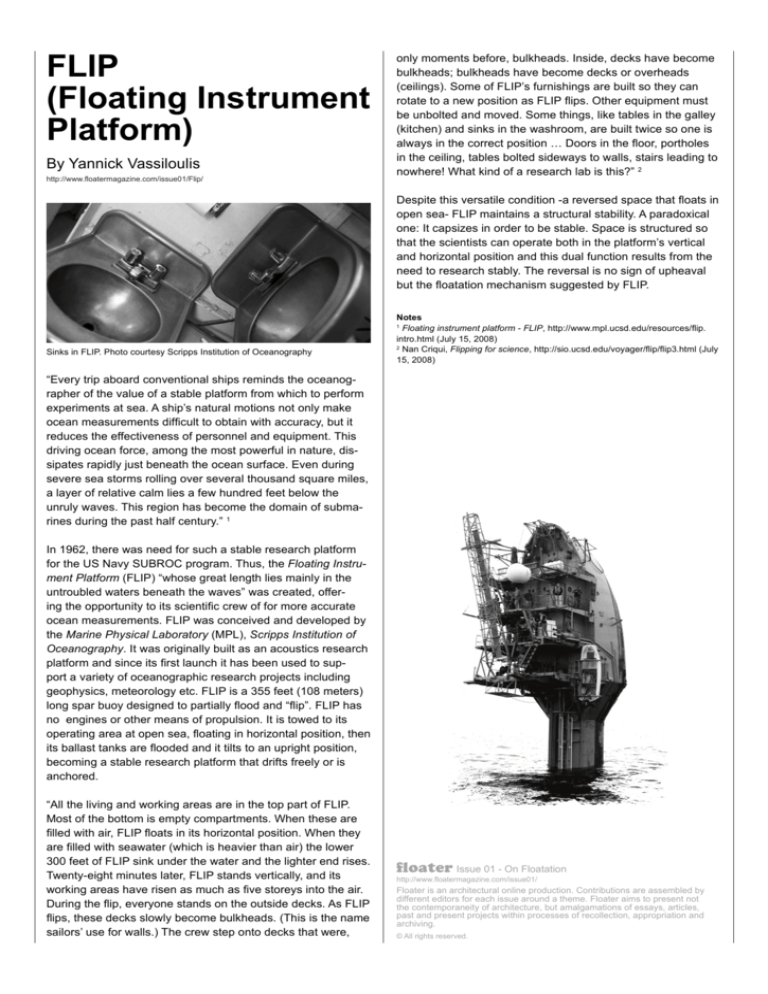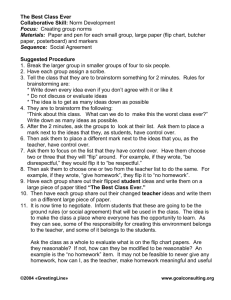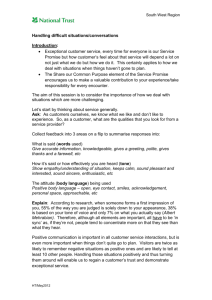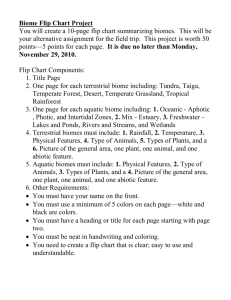
FLIP
(Floating Instrument
Platform)
By Yannick Vassiloulis
http://www.floatermagazine.com/issue01/Flip/
only moments before, bulkheads. Inside, decks have become
bulkheads; bulkheads have become decks or overheads
(ceilings). Some of FLIP’s furnishings are built so they can
rotate to a new position as FLIP flips. Other equipment must
be unbolted and moved. Some things, like tables in the galley
(kitchen) and sinks in the washroom, are built twice so one is
always in the correct position … Doors in the floor, portholes
in the ceiling, tables bolted sideways to walls, stairs leading to
nowhere! What kind of a research lab is this?” 2
Despite this versatile condition -a reversed space that floats in
open sea- FLIP maintains a structural stability. A paradoxical
one: It capsizes in order to be stable. Space is structured so
that the scientists can operate both in the platform’s vertical
and horizontal position and this dual function results from the
need to research stably. The reversal is no sign of upheaval
but the floatation mechanism suggested by FLIP.
Sinks in FLIP. Photo courtesy Scripps Institution of Oceanography
Notes
1
Floating instrument platform - FLIP, http://www.mpl.ucsd.edu/resources/flip.
intro.html (July 15, 2008)
2
Nan Criqui, Flipping for science, http://sio.ucsd.edu/voyager/flip/flip3.html (July
15, 2008)
“Every trip aboard conventional ships reminds the oceanographer of the value of a stable platform from which to perform
experiments at sea. A ship’s natural motions not only make
ocean measurements difficult to obtain with accuracy, but it
reduces the effectiveness of personnel and equipment. This
driving ocean force, among the most powerful in nature, dissipates rapidly just beneath the ocean surface. Even during
severe sea storms rolling over several thousand square miles,
a layer of relative calm lies a few hundred feet below the
unruly waves. This region has become the domain of submarines during the past half century.” 1
In 1962, there was need for such a stable research platform
for the US Navy SUBROC program. Thus, the Floating Instrument Platform (FLIP) “whose great length lies mainly in the
untroubled waters beneath the waves” was created, offering the opportunity to its scientific crew of for more accurate
ocean measurements. FLIP was conceived and developed by
the Marine Physical Laboratory (MPL), Scripps Institution of
Oceanography. It was originally built as an acoustics research
platform and since its first launch it has been used to support a variety of oceanographic research projects including
geophysics, meteorology etc. FLIP is a 355 feet (108 meters)
long spar buoy designed to partially flood and “flip”. FLIP has
no engines or other means of propulsion. It is towed to its
operating area at open sea, floating in horizontal position, then
its ballast tanks are flooded and it tilts to an upright position,
becoming a stable research platform that drifts freely or is
anchored.
“All the living and working areas are in the top part of FLIP.
Most of the bottom is empty compartments. When these are
filled with air, FLIP floats in its horizontal position. When they
are filled with seawater (which is heavier than air) the lower
300 feet of FLIP sink under the water and the lighter end rises.
Twenty-eight minutes later, FLIP stands vertically, and its
working areas have risen as much as five storeys into the air.
During the flip, everyone stands on the outside decks. As FLIP
flips, these decks slowly become bulkheads. (This is the name
sailors’ use for walls.) The crew step onto decks that were,
floater Issue 01 - On Floatation
http://www.floatermagazine.com/issue01/
Floater is an architectural online production. Contributions are assembled by
different editors for each issue around a theme. Floater aims to present not
the contemporaneity of architecture, but amalgamations of essays, articles,
past and present projects within processes of recollection, appropriation and
archiving.
© All rights reserved.










